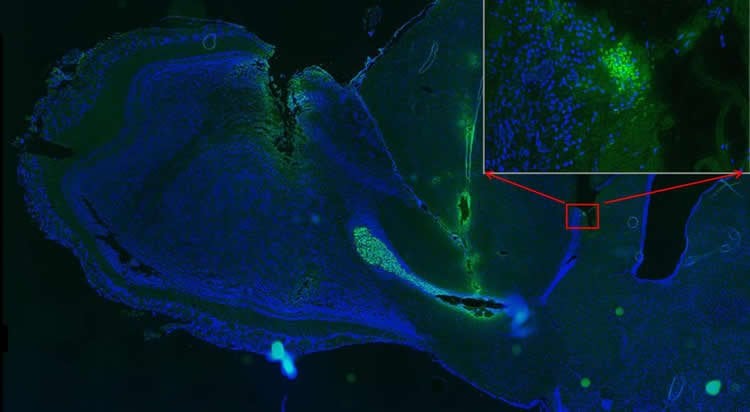Summary: A recent study in Stem Cell Reports suggests electrical fields can be used to help guide transplanted neural stem cells towards a specific location in the brain. The finding could pave the way for new treatments that could help repair brain damage.
Source: UC Davis.
Electric fields can be used to guide neural stem cells transplanted into the brain towards a specific location. The research, published July 11 in the journal Stem Cell Reports, opens possibilities for effectively guiding stem cells to repair brain damage.
Professor Min Zhao at the University of California, Davis School of Medicine’s Institute for Regenerative Cures studies how electric fields can guide wound healing. Damaged tissues generate weak electric fields, and Zhao’s research has shown how these electric fields can attract cells into wounds to heal them.
“One unmet need in regenerative medicine is how to effectively and safely mobilize and guide stem cells to migrate to lesion sites for repair,” Zhao said. “Inefficient migration of those cells to lesions is a significant roadblock to developing effective clinical applications.”
Dr. Junfeng Feng, a neurosurgeon at Ren Ji Hospital, Shanghai Jiao Tong University and Shanghai Institute of Head Trauma, visited Zhao’s lab to study how electric fields might guide stem cells implanted in the brain.
Natural neural stem cells — cells that can develop into other brain tissues — are found deep in the brain, in the subventricular zone and hippocampus. To repair damage to the outer layers of the brain (the cortex), they have to migrate some distance, especially in the large human brain. Transplanted stem cells might also have to migrate some way to find an area of damage.
Stem Cells Move “Upstream”
Feng and Zhao developed a model of stem cell transplants in rats. They placed human neural stem cells in the rostral migration stream – a pathway in the rat brain that carries cells towards the olfactory bulb, which governs the animal’s sense of smell. Cells move along this pathway partly carried by the flow of cerebrospinal fluid and partly guided by chemical signals.

By applying an electric field within the rat’s brain, they found that they could get the transplanted stem cells to swim “upstream” against the fluid flow and natural cues and head for other locations within the brain.
The transplanted stem cells were still in their new locations weeks or months after treatment.
“Electrical mobilization and guidance of stem cells in the brain therefore provides a potential approach to facilitate stem cell therapies for brain diseases, stroke and injuries,” Zhao said.
Additional authors on the paper are: at UC Davis, Lei Zhang, Jing Liu, Bruce Lyeth and Jan Nolta; Ji-Yao Jiang, Ren Ji Hospital, Shanghai Jiao Tong University and Shanghai Institute of Head Trauma; and Michael Russell, Aaken Laboratories, Davis.
Funding: The work was supported by the California Institute for Regenerative Medicine with additional support from NIH, NSF and Research to Prevent Blindness, Inc.
Source: Andy Fell – UC Davis
Image Source: NeuroscienceNews.com image is credited to Junfeng Feng.
Original Research: Full open access research for “Electrical Guidance of Human Stem Cells in the Rat Brain” by Jun-Feng Feng, Jing Liu, Lei Zhang, Ji-Yao Jiang, Michael Russell, Bruce G. Lyeth, Jan A. Nolta, and Min Zhao in Stem Cell Reports. Published online June 29 2017 doi:10.1016/j.stemcr.2017.05.035
[cbtabs][cbtab title=”MLA”]UC Davis “Neural Stem Cells Steered by Electric Fields in Rat Brain.” NeuroscienceNews. NeuroscienceNews, 11 July 2017.
<https://neurosciencenews.com/genetics-stem-cells-neurobiology-7060/>.[/cbtab][cbtab title=”APA”]UC Davis (2017, July 11). Neural Stem Cells Steered by Electric Fields in Rat Brain. NeuroscienceNew. Retrieved July 11, 2017 from https://neurosciencenews.com/genetics-stem-cells-neurobiology-7060/[/cbtab][cbtab title=”Chicago”]UC Davis “Neural Stem Cells Steered by Electric Fields in Rat Brain.” https://neurosciencenews.com/genetics-stem-cells-neurobiology-7060/ (accessed July 11, 2017).[/cbtab][/cbtabs]
Abstract
Electrical Guidance of Human Stem Cells in the Rat Brain
Highlights
•Developed a technology and device delivering electric current to the brain in vivo
•Achieved stable delivery of currents to brain with monitoring and safety concerns
•Exhibited effective guidance of migration of transplanted human NSCs in live brain
•Demonstrated enhanced motility, survival, and differentiation of the guided hNSCs
Summary
Limited migration of neural stem cells in adult brain is a roadblock for the use of stem cell therapies to treat brain diseases and injuries. Here, we report a strategy that mobilizes and guides migration of stem cells in the brain in vivo. We developed a safe stimulation paradigm to deliver directional currents in the brain. Tracking cells expressing GFP demonstrated electrical mobilization and guidance of migration of human neural stem cells, even against co-existing intrinsic cues in the rostral migration stream. Transplanted cells were observed at 3 weeks and 4 months after stimulation in areas guided by the stimulation currents, and with indications of differentiation. Electrical stimulation thus may provide a potential approach to facilitate brain stem cell therapies.
“Electrical Guidance of Human Stem Cells in the Rat Brain” by Jun-Feng Feng, Jing Liu, Lei Zhang, Ji-Yao Jiang, Michael Russell, Bruce G. Lyeth, Jan A. Nolta, and Min Zhao in Stem Cell Reports. Published online June 29 2017 doi:10.1016/j.stemcr.2017.05.035







